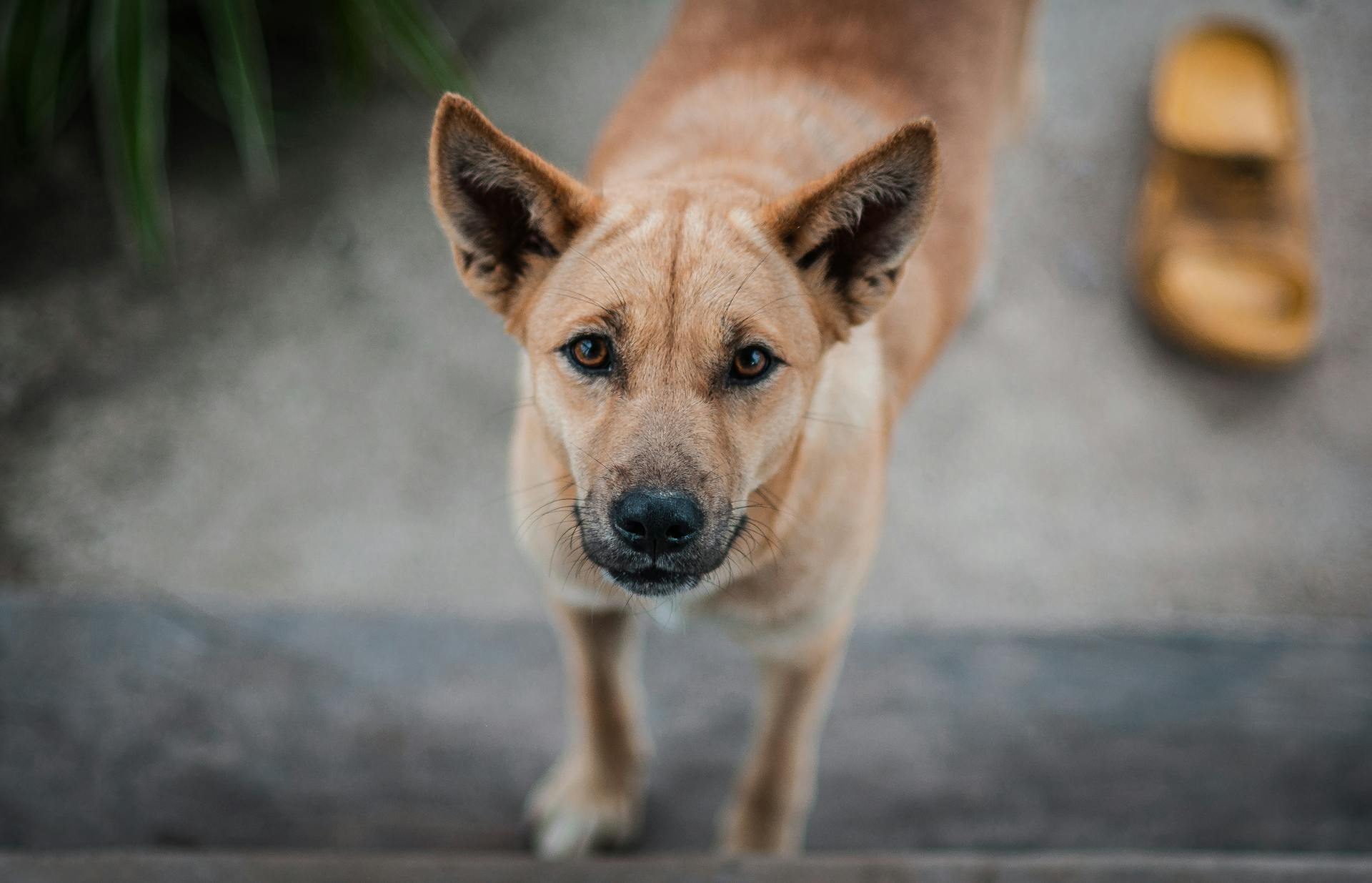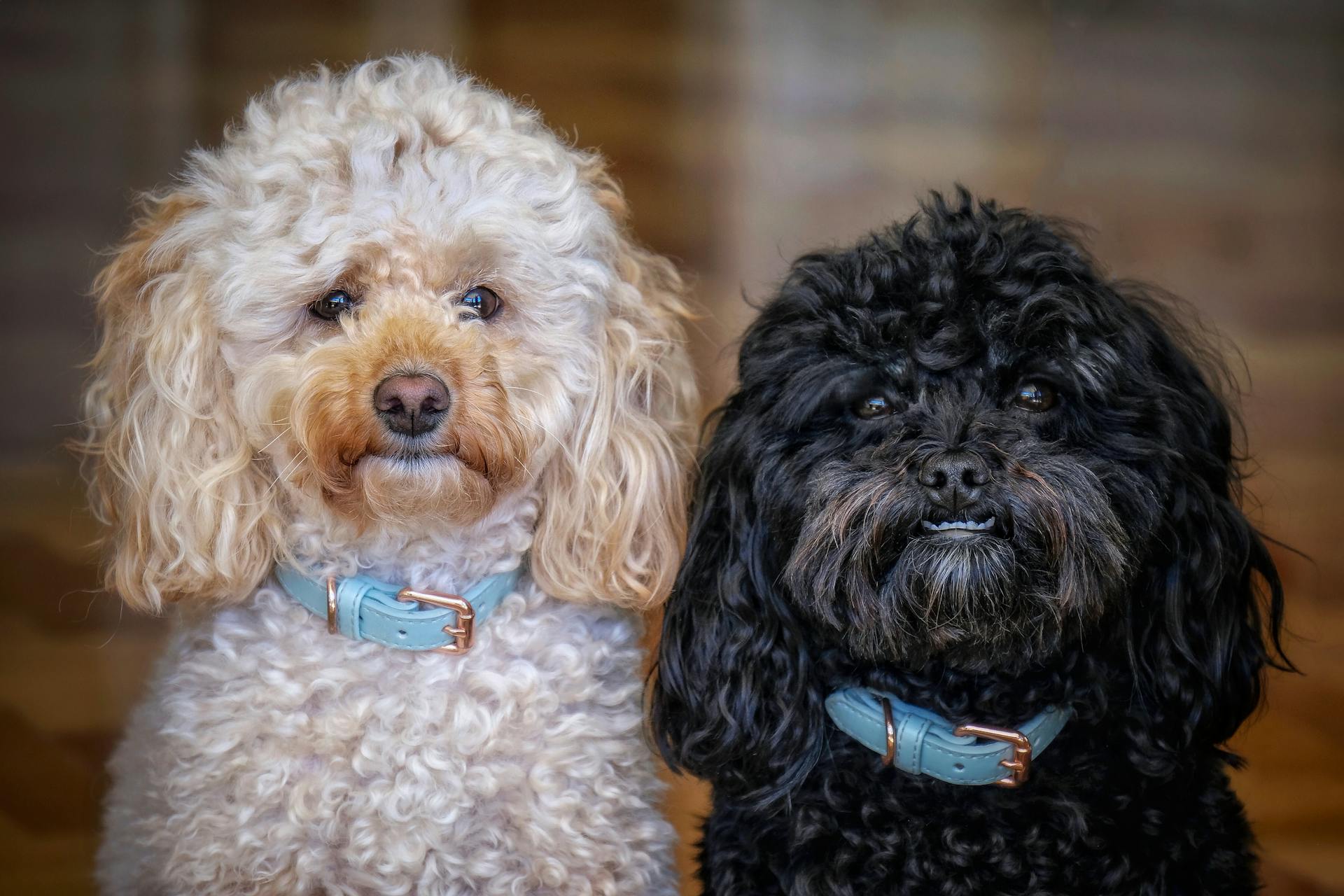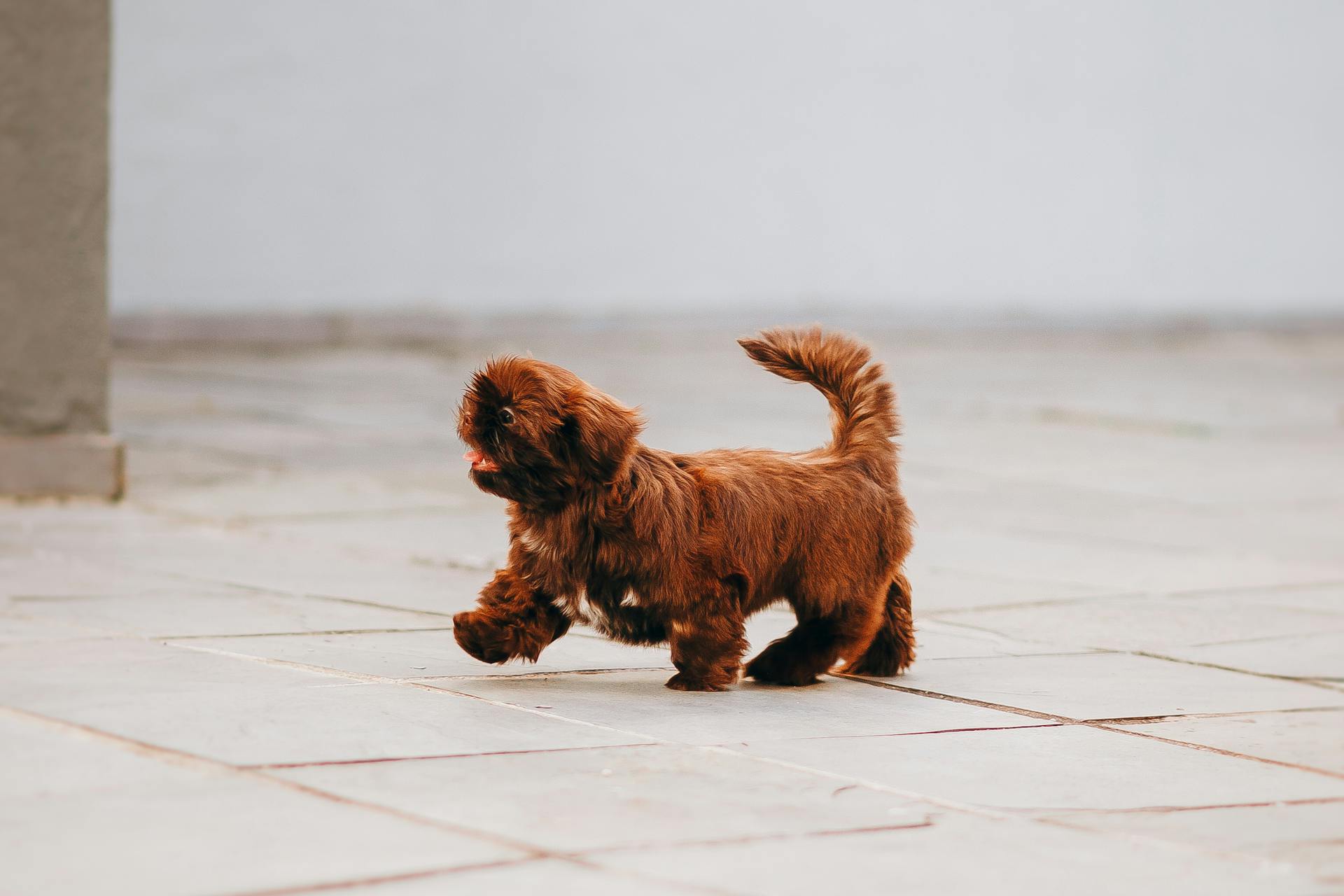
The Tornjak is an ancient breed originating from the Balkans, specifically from Bosnia and Herzegovina.
This breed is known for its distinctive appearance, with a thick double coat that can be either black or white.
Tornjaks are large dogs, with males weighing up to 110 pounds and standing as tall as 28 inches at the shoulder.
They have a muscular build and a wedge-shaped head with a well-defined stop.
On a similar theme: Dogs Breeds That Start with B
Origin and History
The Tornjak breed originated in Bosnia and Herzegovina, specifically in the mountains of Vlasic, where the largest number of Tornjaks was found.
The first written documentation of the breed dates back to 1067 A.D., which included measurements and personality traits.
The breed was originally known as Kanis Montanus or "mountain dog" and was later named Tornjak by locals, which translates to enclosure for sheep.
Studies have suggested that the Tornjak may descend from the Tibetan Mastiff, but no conclusive evidence has been found to support this theory.
You might enjoy: Bosanski Tornjak
The Tornjak has been solely found within Bosnia and Herzegovina for the past thousand years and has the best documented history of all ancient breeds.
In the 1970s, the breed gained increased interest, and systematic recovery from extinction began in Croatia, Bosnia and Herzegovina around 1972, with continuous pure breeding starting in 1978.
The breed was recognized by the United Kennel Club on August 18, 2011, and was finally recognized by the FCI in 2017.
Today, the breed consists of many purebred dogs, with the Tornjak being recognized by the American Kennel Club and included in the organization's Foundation Stock Service category.
You might like: American Kennel Club Lancashire Heeler
Breed Appearance
The Tornjak is a large, powerful dog breed with a well-proportioned body and a square shape.
He has thick bone, but it should not appear overly heavy or coarse. The Tornjak's coat is long and thick, with a double coat that includes a wooly undercoat and a straight, harsh topcoat.
His eyes are large and almond-shaped, with a dark brown color. His nose is large, with wide nostrils and a black color.
The Tornjak's ears are medium-sized, triangular, and folded, carried close to the cheeks. His front legs are well-developed, with strong bones, tight muscles, and well-angulated joints.
Readers also liked: Large Munsterlander
General Appearance
The Tornjak is a large, powerful dog with a well-proportioned body that's almost square in shape.
Its bone structure is strong, harmonious, and well-balanced, making it agile and nimble despite its size.
The length of the body should not exceed its height by more than eight percent, which is a testament to its compact and athletic build.
The Tornjak's coat is long and thick, requiring regular grooming to prevent matting and tangling.
Its skin is thick and well-fitting all over the body, which is essential for its rugged and working heritage.
The Tornjak's head is elongated, with a 1:1 ratio between the length of the skull and the muzzle, giving it a unique and distinctive appearance.
The nose is large, with wide nostrils and dark pigmentation that matches the color of its coat.
Its eyes are dark and almond-shaped, with close-fitting lids and dark pigmentation around the eyelids.
The Tornjak's ears are medium-sized, triangular, and folded, carried close to the cheeks and requiring regular grooming to prevent matting.
You might enjoy: Dark Border Terrier
Forequarters
The forequarters of this breed are quite impressive, with well-developed front legs that have strong bones and tight muscles.
They're also well-angulated, with a scapula-humerus angle of about 120 degrees. This allows for a strong and efficient movement.
The elbows are held moderately close to the body, which is crucial for stability and balance.
The front feet have arched, tightly knit toes, and dark pigmentation is preferred for the nails. The pads are also resilient, hard, and tight.
The front feet are more developed than the hind feet, which is a notable characteristic of this breed.
You might like: How Strong Are German Shepherds
Information and Pictures
The breed's appearance is a great topic to explore. The breed's size is a notable aspect, with some individuals reaching up to 20 inches in height.
Their coats can be a mix of colors, including black, white, and tan. The coat length can vary from short to medium, with some individuals having a longer coat than others.
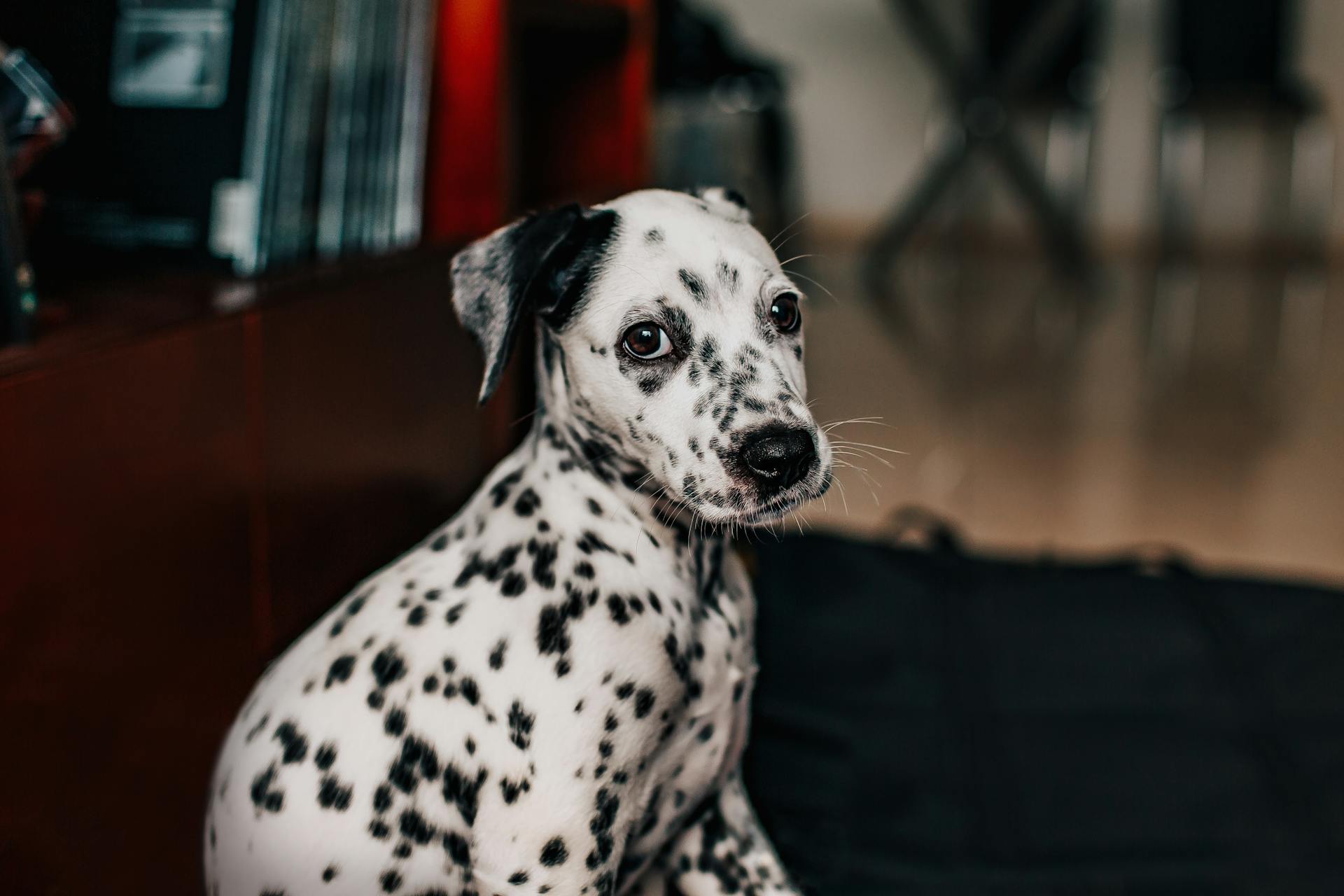
Their ears are triangular in shape and erect, giving them a distinctive look. Their eyes are usually dark brown in color, which can range from a deep brown to a lighter golden brown.
Their body shape is muscular and athletic, with a deep chest and well-sprung ribs. Their legs are strong and straight, with a moderate length.
Their tail is usually docked, but some individuals may have a natural tail.
Recommended read: Bull Terrier Head Shape
Breed Characteristics
The Tornjak is a large and strong dog with a well-proportioned build and good agility. They belong to FCI Group 2 and have the FCI standard number 355.
An adult male Tornjak typically has a shoulder height of 70 cm and weighs around 50 kg, while females are slightly smaller and lighter. The ears are drooping, but not very long, and the coat is long, wavy, and weather-resistant, making them well-suited for outdoor use in winter.
Tornjaks are naturally protective of their territory and can be suspicious of strangers or other dogs and animals, but this can be managed with consistent training and experience.
Related reading: Fci Dutch Shepherd
The Neck
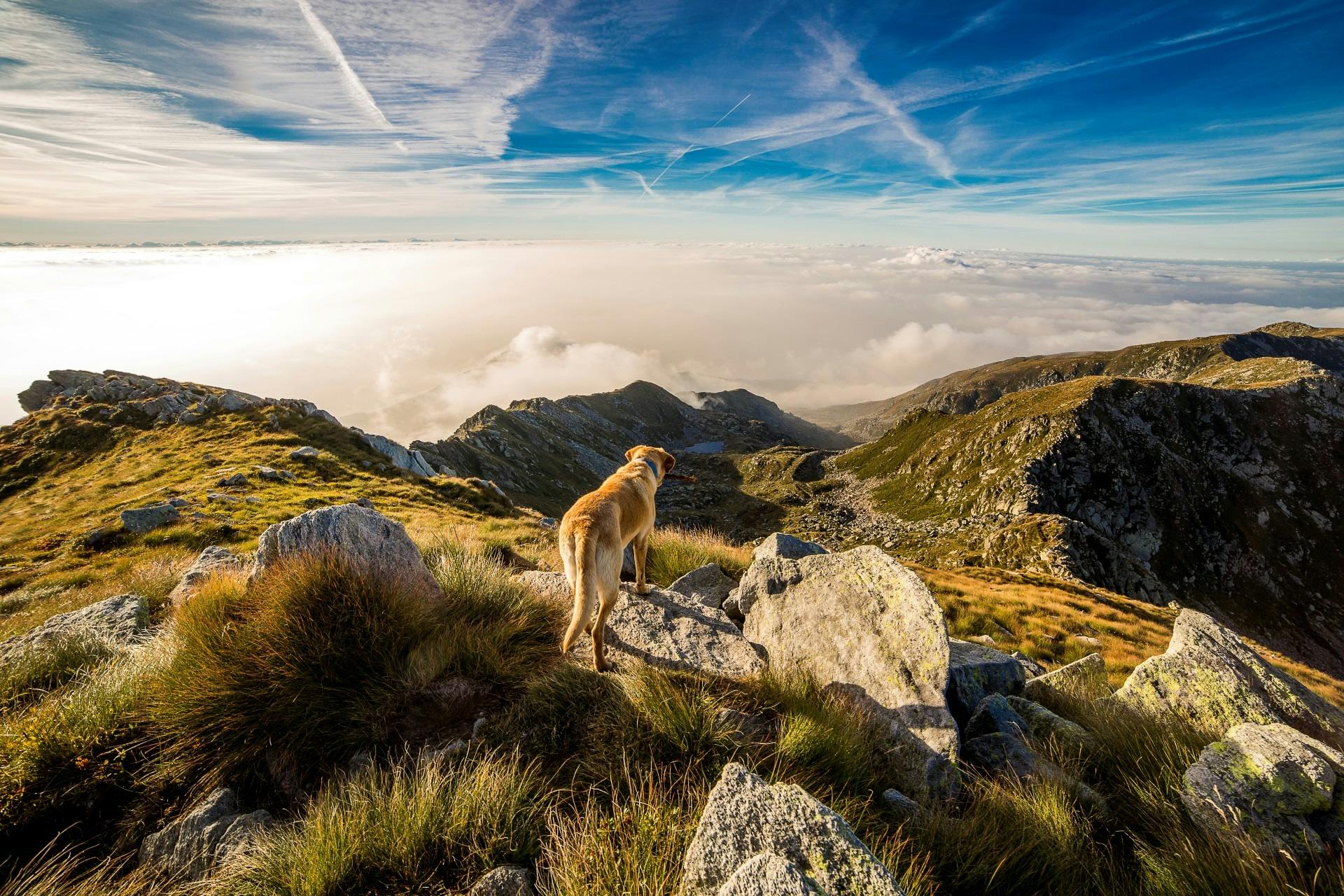
The neck of this breed is a notable feature, carried slightly low and of medium length. It's a powerful neck that exudes strength.
The skin on the neck is tight-fitting, which suggests a lean and athletic build. This is consistent with the breed's overall physique.
A long, abundant coat forms a mane on the neck, adding to its robust appearance. This coat is likely to require regular grooming to prevent matting.
Tail
The tail of this breed is long and very mobile, set at a medium height.
It's a characteristic of the breed that the tail is always raised over the level of the back when in motion.
The tail is abundantly coated, with a distinct plume.
You'll notice that a kinked tail or the absence of a tail are considered faults in this breed.
A tail laid on the back is also not ideal, and a poorly coated tail is another fault to watch out for.
If this caught your attention, see: Straight Back German Shepherds
Gait
The Tornjak's gait is truly a sight to behold. It customarily moves at a trot, which is a testament to its athletic ability.
Movement is well-balanced, with a supple and long-reaching stride that exudes harmony. This is especially noticeable when observing the dog's topline, which remains firm during movement.
Strong drive from the hindquarters propels the Tornjak forward, giving it a confident and energetic stride.
Characteristics
The Tornjak is a large, strong dog with a well-proportioned build and good agility, belonging to FCI Group 2 with the FCI standard number 355.
An adult male Tornjak typically has a shoulder height of 70 cm and weighs around 50 kg, while females are somewhat smaller and lighter.
The breed's coat is long, wavy, and weather-resistant, with a dense undercoat that makes it ideally equipped for outdoor use in winter in unfavorable weather conditions.
The Tornjak's ears are drooping, but not very long, and the breed is generally not considered aggressive, although it can occasionally be suspicious of strangers or other dogs and animals.
Worth a look: Bernese Mountain Dog Cold Weather
Consistent training and experience are crucial in preventing the Tornjak's mistrust from turning into aggression, and with proper training, the breed is willing to obey its owner's commands.
The Tornjak is a self-confident breed that knows how to defend itself and others in an emergency, making it a great companion for families and farmers alike.
Breed Maintenance
The Tornjak's long, dense coat requires regular brushing to prevent matting and tangling. A pin brush and metal comb are ideal tools for this task, and a matt splitter can be used if necessary.
Grooming needs increase during shedding season, with daily brushing recommended to manage heavy shedding. A de-shedder can be used during this time to help remove loose hair.
Bathing is necessary only a few times a year, as the Tornjak has a mild coat that doesn't typically develop a strong doggy smell.
Breed Maintenance
The Tornjak has a long, dense coat that needs regular brushing to prevent matting and tangling. A pin brush and metal comb are ideal tools for the job, and a matt splitter may be necessary if his coat becomes severely tangled.
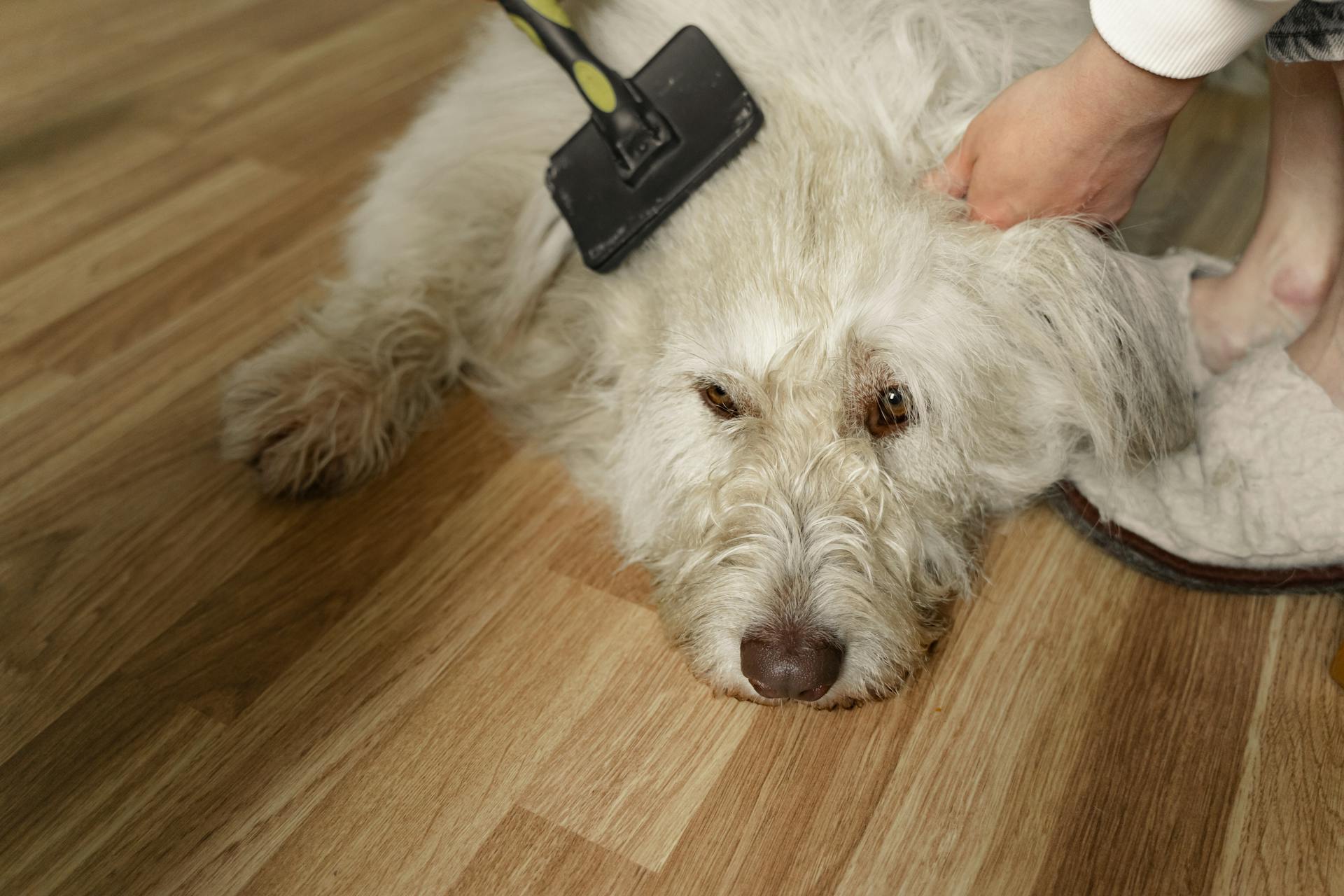
You should plan on brushing your Tornjak at least once a week, but be prepared to do it daily during times of intense shedding. He sheds seasonally, and a de-shedder can be a big help during these periods.
Bathing your Tornjak is a bit of a delicate matter, as he can be prone to drooling. However, he doesn't have a strong doggy smell, so you don't need to bathe him too frequently - just a few times a year should do the trick.
Feeding
A well-balanced diet is crucial for a Tornjak's optimal health.
The breed requires a diet tailored to its medium- to large-sized energy needs, which can be prone to weight gain without sufficient exercise.
Measuring food portions and feeding your Tornjak twice a day, rather than leaving food out continuously, is a good practice.
A Tornjak's dietary needs evolve throughout its life stages, from puppyhood to adulthood, and into its senior years.
Consulting with a veterinarian to determine the most appropriate diet for your Tornjak is highly recommended.
They will consider factors such as the dog's weight, energy levels, and overall health to provide specific dietary recommendations.
For your interest: Best Dog Food for Rhodesian Ridgeback
Suitable Accessories
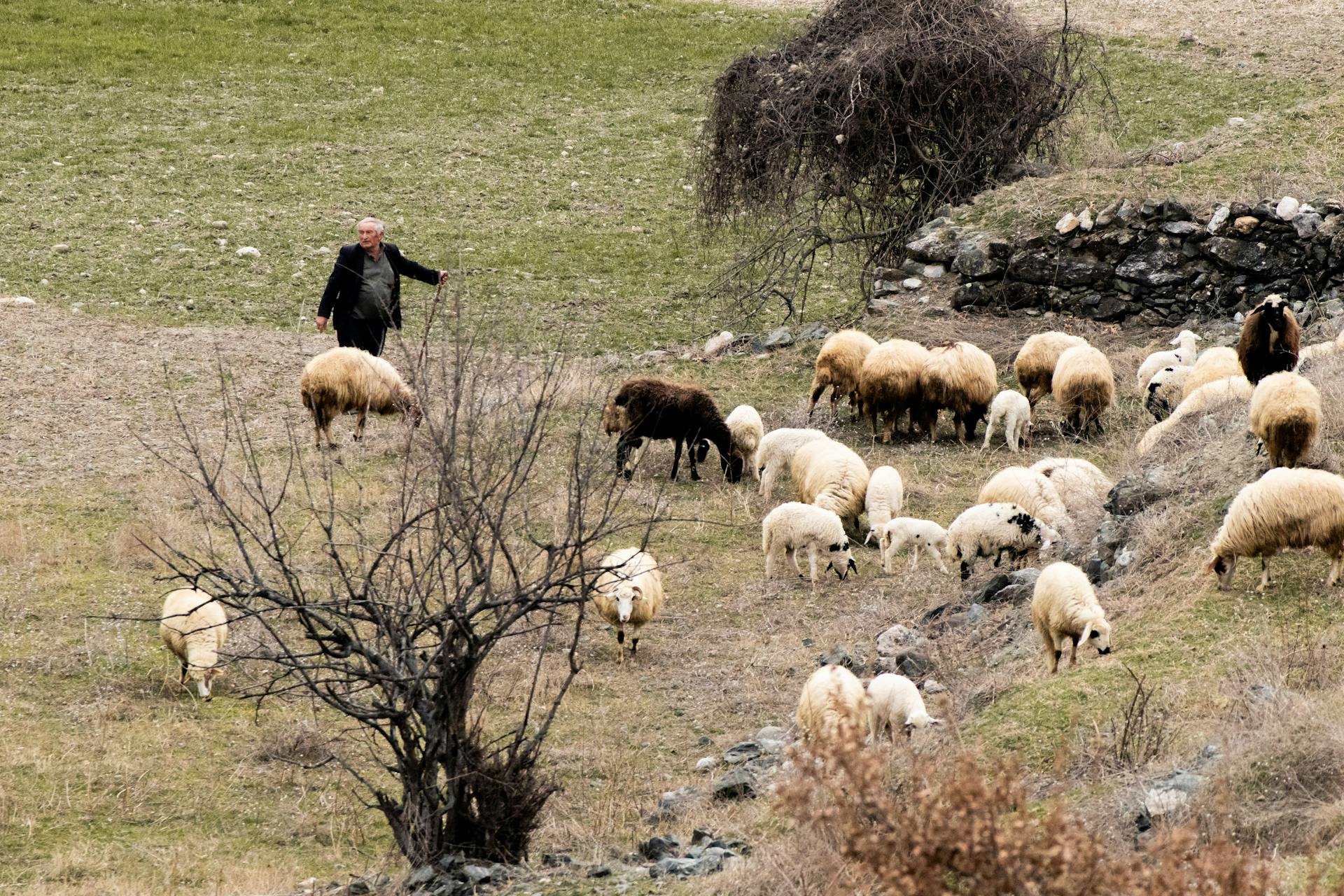
A food bowl and water bowl are required for your Tornjak, just like for any other dog.
You'll also need a lead, collar or harness, especially since your Tornjak is large and strong. A tear-resistant lead that's also soft enough is a must, as a sudden break can cause injuries to your hand.
A secure transport box is necessary for car travel, equipped with safety features to protect your dog in an emergency. Dogs are considered transported goods on public transport, so this is a legal requirement.
Your Tornjak needs a safe place to rest and sleep, so a dog bed in its size is a good idea. A washable and dirt-repellent option is best.
A dog kennel is suitable for outdoor use, such as in the yard. A blanket or cushion can be used as a base.
Regular grooming is essential, so a brush and comb are must-haves. You'll also need toothpaste and a toothbrush for your dog, as well as tick tweezers and claw clippers.
A first aid kit is a must-have, but it's best to consult with your vet to determine what should be included.
Related reading: Dog Breeds That Don't Need Grooming
Similar Maintenance Breeds
If you're looking for breeds that require similar maintenance to the Tornjak, you're in luck. The Pyrenean Mastiff is a great option, as it's 100% similar in terms of maintenance needs.
The Armenian Gampr is another breed that requires the same level of maintenance as the Tornjak, with 100% similarity in their needs.
The Schnug and Spanador are also good choices, with 94% similarity in their maintenance requirements.
If you're looking for a breed that's similar in size to the Tornjak, you might consider the Alaskan Malamute, which is 98% similar in size.
The Curly Coated Retriever and Euro Mountain Sheparnese are also similarly sized to the Tornjak, with 97% similarity in their size requirements.
Here are some breeds that are similar in maintenance and size to the Tornjak:
- Pyrenean Mastiff (100% similar in maintenance)
- Armenian Gampr (100% similar in maintenance)
- Schnug (94% similar in maintenance)
- Spanador (94% similar in maintenance)
- Alaskan Malamute (98% similar in size)
- Curly Coated Retriever (97% similar in size)
- Euro Mountain Sheparnese (97% similar in size)
Frequently Asked Questions
Is a Tornjak a good family dog?
Yes, a Tornjak is a great family dog, known for being gentle and protective of loved ones, especially children. They make excellent companions for families who want a loyal and loving pet.
What are other names for tornjaks?
Other names for Tornjaks include Bosnian Shepherd and Croatian Shepherd Dog.
What is the national dog of Bosnia?
The national dog of Bosnia is the Tornjak, also known as the Bosnian Shepherd dog. This ancient breed is a symbol of Bosnian heritage and culture.
Featured Images: pexels.com
